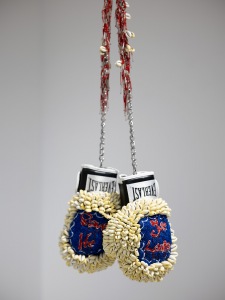
Critics’ Picks
MARIN MUSEUM OF CONTEMPORARY ART
500 Palm Drive
April 2–June 5, 2022
Entering the first of two galleries, we encounter an array of sculptures—on pedestals, suspended from the ceiling, freestanding, and hanging on the walls. Music from Yemen and Ukraine provides a lo-fi soundtrack, emanating from Peter Simensky’s Pyrite Pirate Radio—pink hair I don’t care, 2021, a functional work comprising electronic parts and fool’s gold (or pyrite, which has the ability to capture AM audio transmissions) with sundry decorative embellishments, such as strings of colorful wooden beads and lavender-sequined fabric.
The paradoxical combination of aesthetically pleasing adornments with serious subject matter is echoed in Demetri Broxton’s Save Me, Joe Louis, 2019–20, a pair of boxing gloves encrusted with cowrie shells and intricate beading. The title, stitched into the piece, references the last words of a Southern Black prisoner on death row in the 1930s.
Several artists incorporate everyday objects with culturally specific approaches and materials to complicate ideas surrounding identity. In Natani Notah’s haunting Hooked, 2022, a piece of leather enhanced with Native American beadwork is sewn onto a found metal hook, turning a mass-produced symbol of danger and violence into something much stranger, richer, and emotionally complex. The work also asserts the validity and superiority of Native American techniques in contemporary art. Cathy Lu’s American Dream Pillows, 2020, are stylized porcelain masks that rest on blue packing blankets draped over cinder blocks. The works were inspired by Song and Tang dynasty ceramic pillows, designed to guide dreams. The contrast between the anticipation of a comfortable bed and the sculptures’ forbidding atmosphere signals a disconnect: between the false perception of the United States as a place where prosperity and success are possible for anyone who comes here, and the reality of the country’s deep-rooted xenophobia and racism.
